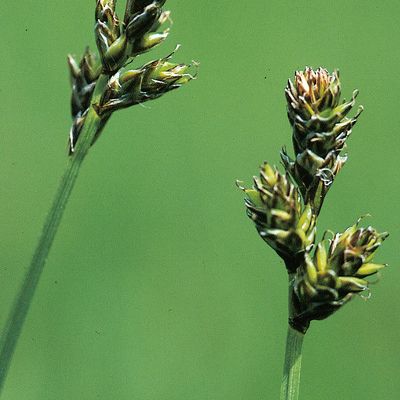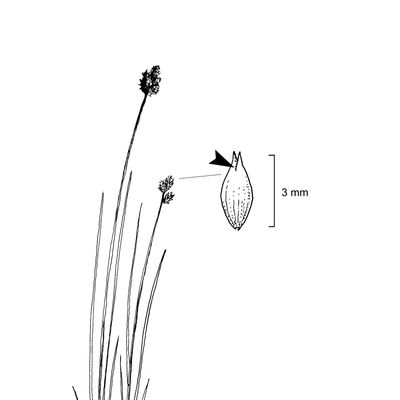Carex heleonastes L. f.
1009870
Species
ISFS : 88500
Checklist : 1009870
ISFS : 88500
Checklist : 1009870
Contains :
Synthesis
Species description (© Flora Helvetica 2018)
10-30 cm hoch. Stängel 3kantig, steif aufrecht, oben stark rau. Blätter 1,5-2 mm breit, graugrün, steif, rinnig, meist kürzer als der Stängel. Blütenstand meist kopfig, 1-2 cm lang, mit 3-5 Ährchen, mit oder ohne Hochblatt. Ährchen 3-7 mm lang, unten männlich, oben weiblich. Narben 2. Deckspelzen braun, mit breitem Hautrand. Fruchtschläuche braun, allmählich in einen kurzen, aussen aufgeschlitzten Schnabel verschmälert, 2,5-3,5 mm lang.Flowering period (© Flora Helvetica 2018)
5-6Habitat and distribution inside Switzerland (© Flora Helvetica 2018)
Schlammböden in Hochmooren / kollin-subalpin / MZ, ME, ANZ, ANE, GR, JSWorld distribution (© Flora Helvetica 2018)
Eurosibirisch-nordamerikanischEcological indicator (© Landolt & al. 2010)
4+w+21-432.h.2n=56Status
IUCN status
EndangeredNational Priority
2 - high national priorityInternational responsibility
2 - mediumConservation
Threats
Torfabbau, späte Auswirkungen früherer Torfstiche (v. a. Austrocknung)
Natürliche Sukzession
Beweidung, Eutrophierung
Verbuschung, Verwaldung
Wasserstandregulierung
Wenige, isolierte Populationen (gestörte Populationen lassen sich sehr schlecht regenerieren)
Distribution map
Habitat and distribution inside Switzerland
MZ, ME, ANZ, ANE, GR, JSWorld distribution
Eurosibirisch-nordamerikanischEcology
Life form
Perennial hemicryptophyte
Habitats
Milieux Phytosuisse (© Prunier et al. 2017)
Habitats © Delarze & al. 2015
 | 2.2.4 - Übergangsmoor (Caricion lasiocarpae) |
bold
Dominant species, influencing the appearance of the habitat
 Character species
Character species
 Less strictly linked to a specific habitat
Less strictly linked to a specific habitat
Ecological indicator values by © Landolt & al. (2010)
| Soil factors | Climatic factors | Salinity tolerance | |||
|---|---|---|---|---|---|
| Humidity Value H | 4+w+ | Light Value L | 4 | Salinity Index | -- |
| Reaction Value R | 2 | Temperature factor T | 3 | ||
| Nutriments value N | 1 | Continentality K | 2 | ||
- Ecological values legend
Humidity Value H 1 very dry 1+ dry 2 moderatly dry 2+ moist 3 medium wet 3+ wet 4 very wet 4+ soggy 5 submerged or underwater f plants living in running water u mostly submerged plants v partly submerged, partly floating plants w humidity moderately variable (± scale of 1-2) w+ highly variable humidity (scale exceeding ± 2) Reaction Value R 1 Very acid (pH 2.5-5.5) 2 acid (pH 3.5-6.5) 3 lightly acid to neutral (pH 4.5-7.5) 4 neutral to basic (pH 5.5-8.5) 5 basic (pH 6-5 -> 8.5 Nutriments value N 1 very low in nutrients 2 low in nutriments 3 medium-poor to medium-rich in nutrients 4 rich in nutriments 5 very rich in nutriments Salinity tolerance 1 halotolerant 3 halophyle Light Value L 1 very shady 2 shady 3 lighted areas 4 luminous 5 highly luminous Temperature factor T 1 alpine to nival stages (from the treeline to the snowline) 1+ suprasubalpine and upper subalpine levels (pine and larch forests) 2 subalpine level (coniferous forests without beeches up to the upper limit of spruces) 2+ lower subalpine and upper mountain stages 3 mountain level (beech and silver fir forests, in the central Alps Scots pine forests) 3+ lower mountain and upper hill levels 4 hill level (mixed deciduous oak forests) 4+ hot places, hill level 5 very hot places, hill level (only in the hottest places, typical of southern Europe) Continentality K 1 Atlantic (high air humidity, very low temperature variations, mild winters) 2 Sub-Atlantic (high air humidity, low temperature variations, relatively mild winters) 3 sub-Atlantic to subcontinental (average air humidity, moderately variable temperature, slightly low winter temperatures) 4 subcontinental (low air humidity, large temperature variations, rather cold winters) 5 continental (very low air humidity, very large temperature variations, cold winters)
Water dependency
| Rivers | 0 - No link |
| Calm water | 1 - Secondary habitat |
| Ground water | 0 - No link |
Nomenclature
Accepted Name (Checklist 2017)
Carex heleonastes L. f.
Vernacular name
Deutscher Name :
Torf-SeggeNom français :
Laîche des tourbièresNome italiano :
Carice della fanghigliaMatch with other reference books
| Relation | Nom | Book | No |
|---|---|---|---|
| = | Carex heleonastes L. f. | Checklist 2017 | 88500 |
| = | Carex heleonastes L. f. | Flora Helvetica 2001 | 2538 |
| = | Carex heleonastes L. f. | Flora Helvetica 2012 | 2714 |
| = | Carex heleonastes L. f. | Flora Helvetica 2018 | 2714 |
| = | Carex heleonastes L. f. | Index synonymique 1996 | 88500 |
| = | Carex heleonastes L. f. | Landolt 1977 | 486 |
| = | Carex heleonastes L. f. | Landolt 1991 | 425 |
| = | Carex heleonastes L. f. | SISF/ISFS 2 | 88500 |
| = | Carex heleonastes L. f. | Welten & Sutter 1982 | 2446 |
= The taxon corresponds to the accepted taxon (Checklist 2017)
< The taxon is included in the accepted taxon (Checklist 2017)
> The taxon includes (among others) also the accepted taxon (Checklist 2017)
< The taxon is included in the accepted taxon (Checklist 2017)
> The taxon includes (among others) also the accepted taxon (Checklist 2017)
Status
Native status
-IUCN list of endangered species (© Walter & Gillett 1997) : No
Status on national Red List 2016
IUCN status:
Endangered

Additional information
IUCN criteria: B2ab(ii,iii); C2a(i)
Status on regional Red List 2019
| Biogregraphic regions | Status | IUCN criteria |
|---|---|---|
| Jura (JU) | CR | C1 |
| Mittelland (MP) | RE | |
| Alpennordflanke (NA) | EN | B2ab(ii,iii); C2a(i) |
| Alpensüdflanke (SA) | -- | |
| Östliche Zentralalpen (EA) | -- | |
| Westliche Zentralalpen (WA) | -- |
- Legend
EX Extinct RE Regionally Extinct CR(PE) Critically Endangered, Probably Extinct CR Critically Endangered EN Endangered VU Vulnerable NT Near Threatened LC Least Concern DD Data Deficient NE Not Evaluated NA Not Applicable
National Priority Species List Status
| National Priority | 2 - high national priority |
| Need to take action | 2 - |
| International responsibility | 2 - medium |
| Need to monitor populations | 2 - |
Protection status
| International (Bern Convention) | No | |
| VD | total protection | (02.03.2005) |
| Switzerland | -- |
- Disclaimer
InfoFlora compiles information on protected species as accurately as possible, taking it from the respective cantonal laws. In some cases, however, it was not possible to use the plant names as listed in the original text, but an interpretation of their taxonomy or nomenclature was necessary. The exact meaning of the categories „completely protected“ and „partially protected“ differs among the cantons.
InfoFlora cannot guarantee that the information on the protection status is correct and complete. In case of doubts, we recommend to look up the texts of the respective cantonal law.
Status by sector of activity
| Agriculture-related environmental objectives : | more informations | |
| Forest management environmental objectives : | more informations |
Conservation
Threats and measures
Torfabbau, späte Auswirkungen früherer Torfstiche (v. a. Austrocknung)
Kein Torfabbau
Wasserhaushalt stabilisieren und an einigen Fundstellen lokal vernässen
Natürliche Sukzession
Vorsichtige Reduktion von Konkurrenzpflanzen, jedoch Schonung anderer seltener Arten.
In Nachbarschaft der Fundstelle(n) flache Mulden schürfen: Auspflanzungen aus Ex situ-Vermehrung.
Beweidung, Eutrophierung
Einzäunen
grosse Pufferzonen
Verbuschung, Verwaldung
Offenhalten der Moorfläche, entbuschen
Wasserstandregulierung
Natürliches Wasserregime erhalten
Wenige, isolierte Populationen (gestörte Populationen lassen sich sehr schlecht regenerieren)
Schutz inkl. grossen Zonen mit gutem Pufferungsvermögen
regelmässige Bestandskontrollen
Dauerflächen-Beobachtung
Detailkartierung der Vorkommen mit der Methode PopCount
ex-situ-Vermehrung als Erhaltungskulturen
Erfolgskontrollen der Massnahmen gewährleisten. Verstärkung bestehender Populationen und Ansiedlung neuer Populationen durch Anpflanzung (nach Zwischenvermehrung)


